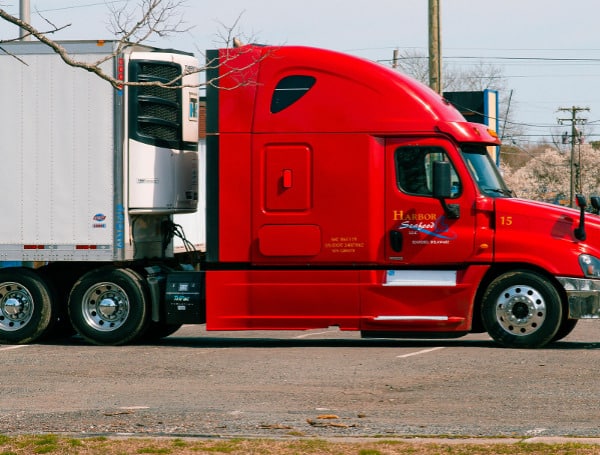Tractor-Trailer (File) By Nick Pope, DCNF. The Biden administration released a strategy Tuesday to electrify America’s long-haul trucking routes i
The Biden administration released a strategy Tuesday to electrify America’s long-haul trucking routes in the coming years as other electric vehicle (EV) charging programs have so far failed to spur the national charging network the administration foresees.
The Joint Office of Energy and Transportation (JOET) — a federal body focused on electrifying American transportation — released the National Zero-Emission Freight Corridor Strategy detailing how the administration is planning to build out a web of EV and hydrogen chargers across the country’s freight-shipping roadways by 2040.
The administration published its plan for developing a heavy-duty EV charging network after reports have emerged suggesting that related subsidy programs for chargers of smaller EVs have so far failed to spur the buildout of a national charging network as envisioned.
Read: Florida AG Ashley Moody Warns Spring Breakers About The Dangers Of Deadly Fentanyl
The administration is looking to build out chargers for heavy-duty vehicles in four steps, according to the National Zero-Emission Freight Corridor Strategy. First, the administration will build charging hubs in highly trafficked hubs before connecting those corridors, expanding charger availability along those routes and doing so until the national network is completed.
The strategy further states that it meets administration goals for the green agenda by “[providing] clear market signals” and “maximizing the efficient use of resources,” according to its text. The administration is also maneuvering to ensure that at least 40% of the benefits of the first, third and final phases of truck chargers will flow to “disadvantaged communities.”
The Biden administration has a stated goal of having zero-emissions vehicles comprise 100% of all new medium- and heavy-duty vehicles sold in the U.S. by 2040, according to the report.
Read: Florida Rep. Greg Steube Erupts Over Biden “Illegal” Focus And Not The Woman Murdered
The administration is implementing programs included in the 2021 bipartisan infrastructure bill to subsidize EV charger development for the smaller EVs that it also wants to see dominate America’s auto market in the 2030s, but those programs had only resulted in eight charging stations coming online across the country as of late February, according to a letter to Biden administration officials sent by several Republicans on the house Energy and Commerce Committee.
However, a JOET spokesperson told the Daily Caller News Foundation that those programs are showing strong signs of promise as funding opportunities and logistical preparations continue to progress nationwide.
“A core objective of the strategy is to meet freight truck and technology markets where they are today, determine where they are likely to develop next, and set an ambitious pathway that mobilizes actions to achieve decarbonization,” the JOET spokesperson told the DCNF regarding the strategy plan released Tuesday. “It serves as a compass for public and private stakeholders to prioritize and guide investment, planning, and deployment of zero-emission medium- and heavy-duty electric charging and hydrogen refueling infrastructure along the National Highway Freight Network and complementary roadways” and “builds on what’s working, starting in states with zero-emission-vehicle-enabling policies and where industry and fleet investments are focused and building momentum to scale deployment around the nation,” the spokesperson added.
Read: Florida Sen. Marco Rubio Renews Push To End “Stupid Practice Of Changing Our Clocks” DST
Other issues appear to complicate the administration’s vision for a relatively seamless transition to electric trucking.
“Electric trucks in particular have limited range based on numerous factors (weight, outside air temperature, etc.), and many cannot operate much over 250 miles before needing to be recharged (diesels can operate well over 1,000 miles depending on fuel tank size),” Joe Rajkovacz, director of governmental affairs and communications for the Western States Trucking Association, previously told the DCNF. “The recharging times (supposing there are sufficient charging points), can take hours, not minutes as with diesel. This takes away significantly from the hours of service drivers are allowed daily under both state and federal regulations.”
In addition to logistical issues with charging electric big rigs, there are also potential issues with the weight of electric trucks. According to Inside EVs, the loaded Tesla semi-truck weighs more than 80,000 pounds, much more than the 25,000 to 35,000 pounds that unloaded diesel equivalents typically weigh. The extra weight of EVs could ultimately accelerate wear and tear on America’s roadways and force more frequent repair work.
The costs of electric trucks are much higher than diesel alternatives as well. Electric big rigs, while not yet widely available, are expected to cost nearly twice as much as diesel equivalents by 2025, according to projections devised by the International Council on Clean Transportation.
Read: Rep. Matt Gaetz Reveals Biden Admin May Use Navy To Stop Anticipated Haitian Migration Into Florida
“These vehicles are far more expensive and cost-prohibitive for most truckers,” Jeremy Kirkpatrick, a spokesperson for the American Trucking Association, previously told the DCNF. He also noted that “96% of trucking companies in this country are small businesses operating ten trucks or fewer. The charging infrastructure is nowhere near in place, and even if it was, there’s not electricity on the grid to power the fleet.”
The White House, Department of Energy and Department of Transportation did not respond immediately to requests for comment.
Help support the Tampa Free Press by making any small donation by clicking here.
Android Users, Click To Download The Tampa Free Press App And Never Miss A Story. Follow Us On Facebook and Twitter. Sign up for our free newsletter.

